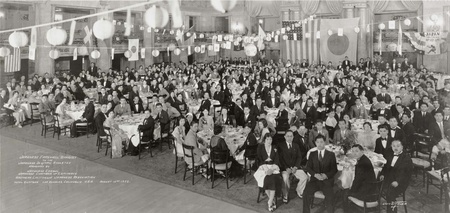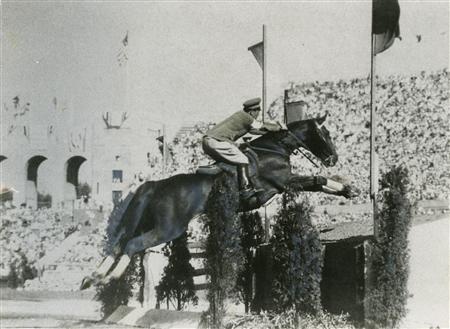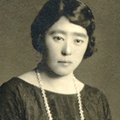Nisshoki ga
Sutadiamu no men masuto ni agatta
Ima dewa yume de nakunatta.
Kakkoku tokutenhyo ni
Nihon wa gungun nobotte yuki.
Rosanjerusu no aozora ni
Sanran to, jitsuni sanran to
Hirugaette iru
Nisshoki no ikuhon.
Kangeki no kiwami de, mi wa furueru.
Kanki no namida ga mazu otsuru.
Yushowa yushowo gekisan suru.The flag of the rising sun
Went up the main mast.
It is no longer a dream.
On the scoreboards for each nation
Japan’s points are rising fast.
Gloriously, truly gloriously
Several Japanese flags are fluttering
Against Los Angeles’ blue sky.
My body shakes with emotion.
Tears of joy well up in my eyes.
Victories extol victories.Sayoko Ishiawa, “Hirugaeru Nisshoki,” Rafu Shimpo, August 11, 1932
Introduction
How many people today still remember the 1932 Olympics? Probably not very many, after almost seven decades have passed and as many other exciting and controversial Olympic Games have taken place since then. In the modern Olympics’ century-long history, the Xth Games, held in Los Angeles, are remembered as an unexpected success; despite the worldwide economic depression that seemed to foredoom the event, it was blessed with excellent weather, record-breaking athletic performances, huge crowds, and large revenues.
It was also a noteworthy milestone in Japanese American history. Although the Games are mostly forgotten and rarely mentioned today, the event had a very special meaning for the prewar Japanese American community. For Issei and Nisei, the 1932 Olympics realized their dreams of seeing Japan win athletic fame on American soil; their hopes for Japan’s Nisshoki (sun flag) and national anthem were fulfilled right before their eyes. Any Los Angeles Nisei who can remember it today will tell you stories about the joy, excitement, and pride they felt that summer, but many Issei and Nisei witnesses to this special event passed away without sharing their memories.
Artifacts at the Japanese American National Museum, stories in Japanese American newspapers such as The Rafu Shimpo and Kashu Mainichi, and other historical materials allow us to trace the meaning of the 1932 Olympics as an important part of Japanese American history. Through this aspect of a particular ethnic group’s history of Los Angeles history is also revealed: how a minority immigrant group helped make the Olympics a success. It is also a part of Japanese history, in which Japan’s athletic achievements could not have been possible without the support from Issei and Nisei in Southern California.
Japan and the Olympics
The 1932 Games were the first where an Asian nation’s athletes did well against their Western counterparts. Among the 39 countries participating, Japan ranked fifth with 31 points, which was a significant improvement over its Olympic debut two decades earlier. Japan sent two runners to the VIth Games in Stockholm in 1912, but neither could complete their races because of fatigue. The VIIth games were canceled because of World War I, but when the Olympics resumed in 1920, Japan sent larger groups of athletes each time (15 to Antwerp, 19 to Paris, and 43 to the Amsterdam Games), resulting in ever-increasing scores. In the 1928 Amsterdam Games, Japan won two gold medals (Mikio Oda in the men’s hop-step-jump and Yoshiyuki Tsuruta in the men’s 200-meter breaststroke) and one silver (Kinue Hitomi in the women’s 800 meter track-and-field event). In the final rankings, Japan’s athletes placed eighth.
Japan sent a delegation of about 200 to the Los Angeles Olympics; this number included 142 athletes and was headed by Dr. Seichi Kishi. Among the 2,000 athletes from all over the world who participated, Japan’s was the second largest group. The United States, as the host country, had the largest delegation by far with more than 500 competitors.
Japanese athletes competed well, especially in track-and-field, swimming, and equestrian events. The world-record holder in the broad jump, Chuhei Nambu, finished third in the event, but he won first place in the hop-step-jump, and Kenkichi Oshima came in third. In the pole vault, competition for the gold medal was fierce between Shuhei Nishida and American William Miller; although Nishida finished second with a vault of 14 feet, he broke the previous Olympic record as well as his own personal best. In the marathon, Seiichiro Tsuda and Onbai Kin took fifth and sixth places. Japan’s track-and-field team ranked fifth in the overall standings. Japan’s women’s track-and-field team did not do well, but its captain, Misako Shimpo, was fourth in the javelin throw.

Japan’s swimming teams, especially the men’s, set several new records, thus proving themselves to be number one in the world. In the 100-meter freestyle, Yasuji Miyazaki, Tatsugo Kawaishi, and Naruo Takahashi won first, second, and fifth respectively. Masaji Kiyokawa, Toshio Irie, and Kentaro Kawazu swept the top three positions in the 100-meter backstroke, their victories provided Japanese spectators with the rare and wonderful sight of three Nisshoki at the winners’ flag stands. In the 200-meter breaststroke, Tsuruta retained his gold medal, and he was accompanied by Reizo Koike in second place. In the 1,500-meter freestyle, Kazuo Kitamura and Shozo Makino won first and second places. Japan also won third, fourth, and fifth places in the 400-meter freestyle, as well as first place in the 800-meter relay. On the women’s team, Hideko Maehata won second place in the 200-meter breaststroke, missing gold by just one-tenth of a second.
The youngest member of Japan’s equestrian team, 31-year-old Takeichi Nishi, added another gold medal to Japan’s total on the day of the closing ceremony. The Lieutenant Baron’s individual victory in the Prix des Nations marked Japan’s first in any equestrian event.
Issei, Nisei, and the Olympics
The Nikkei community around the world enthusiastically helped finance Japan’s participation in the 1932 Olympics; they were determined not to let the difficult economic situation engendered by the Depression prevent Japanese athletes from reaching Los Angeles. The Southern California Japanese American community was especially eager to support Japanese athletes. They contributed monetary donations, facilitated the athlete’s accommodations and practice sessions, and entertained them with great enthusiasm. Upon their arrival—some came as early as May—Japanese athletes were greeted by the national anthem and community members holding Japanese flags, and the warm welcomes and enthusiastic cheers continued until their departure from Los Angeles. One newspaper reported that even young Nisei children who learned of Japan’s lack of funds solicited help “to send their big brothers and sisters to compete on the world stage.” Some support groups went so far as to raise funds to rent a pool so that the Japanese swimming team could practice.
Such assistance from the local Japanese community was essential for the Japanese team’s success. Although the United States was certainly suffering from the effects of the Great Depression, Japan was far worse off, its economic situation especially aggravated by the weak yen in the early 1930s. By then, the Japanese immigrant community in Los Angeles was a significant entity: among the 138,000 Japanese (foreign- and US born) living in the United States, 35,000 resided in the Los Angeles area, and Little Tokyo was a bustling ethnic center where Japanese food and services were available.
Various kenjinkai (prefectural associations), merchant organizations, Japanese-language schools, and other Japanese organizations were in operation, and many actively contributed to the campaign to ensure Japan’s participation in the Xth Olympics. Two Issei organizations, the Central Japanese Association and the Los Angeles Japanese Association, created a Nihon Senshu Koen Kai (Support Association for Japanese Athletes) in conjunction with the Los Angeles Japanese Consulate and Dai Nippon Taiiku Kyokai (the representative of the Japanese teams). The Koen Kai raised the then-huge sum of $7,215.24 to help subsidize the Japanese delegates’ expenses.
The local Japanese American community created a slogan and accompanying logo for the Xth Olympics: “Nihon wo kataseyo” (Make Japan Win). The graphic symbol showed the Japanese and U.S. flags and the five Olympic rings, symbolizing the community’s hope for Japan-U.S. friendship and world peace.
In a sense, Japanese American enthusiasm for the 1932 Los Angeles Olympics was a reflection of the harsh history of the community’s exclusion in the United States. After passage of the 1924 Immigration Act, new Japanese immigration was terminated. While Issei were declared ineligible to citizenship, American-born Nisei were considered “unassimilable”; both generations had to struggle with the question of how to be accepted in American society. The Issei were particularly concerned about the future of the ever-increasing Nisei population that was about to surpass theirs in number. The Issei hoped that success in the Olympics would show Japan’s excellence to Nisei and thus boost their ethnic pride.
The Japanese American community was swept up by Olympic fever. Issei and Nisei crowded in and around the stadium, poolsides, the marathon course, or wherever Japanese athletes were competing. According to Mikio Oda’s memoirs, large crowds at practice sites made the athletes nervous—and the spectators were eventually barred—because they cheered heatedly as if they were watching real games. Little Tokyo thronged with people wanting to hear live broadcasts of the Games by the Kashu Mainichi or see the billboard where updates on the Japanese team’s results were posted. When a Japanese athlete seemed likely to win an event, local Japanese occupied many of the seats at the venue, making it look like a “Japan Day.” It is estimated that Japanese Americans as a whole spent $100,000 on tickets. Several thousand Japanese Americans attended the closing ceremony to see Japan’s 12 swimming victories and the equestrian victory honored with the raising of the Japanese flag on the pole. While those inside the stadium watched and cried tears of joy, many others without tickets stood outside the stadium just to listen to the Japanese national anthem. The Los Angeles Japanese Chamber of Commerce’s report in October 1932 declared the Xth Olympics a wonderful event, adding: “Even though the Olympic torch is extinguished, the Games’ impressions deeply engraved in people’s memory will stay for a long time.”
Heroes and Heroines
The 1932 Olympics enhanced the fame of older athletes such as Mikio Oda, Chuhei Nambu, Yoshiyuki Tsuruta, and Takeichi Nishi, while new stars such as Shuhei Nishida, Yasuji Miyazaki, Masaji Kiyokawa, and Hideko Maehata emerged. The Japanese American community treated these Japanese athletes as warmly and generously as if they had been great dignitaries. The heroes and heroines of land and water were invited to numerous receptions and parties, given gifts, asked for autographs, and always received enthusiastic attention. Although the medal winners were honored most highly, lavish hospitality was extended regardless of performance. Prefectural affiliations, for example, meant a great deal. Mitsue Ishizu of Hiroshima, who did not place in the discus-throw event, was nonetheless called a champion and received gifts that included a diamond ring.
Collecting autographs became a fad at the Olympics: athletes exchanged autographs to deepen their friendship, while fans looked for every opportunity to obtain signatures. Many waited at the entrance to the Olympic Village—which were surrounded by barbed wire and restricted to Olympic athletes and officials—to grab competitors. The Museum has an example of the autograph mania in its collection, a small book that contains the autographs of several Japanese athletes.
On the last day of the Games, a farewell dinner-dance and banquet was held for the Japanese team and Japanese American community members and leaders at the Biltmore Hotel in downtown Los Angeles, under the joint auspices of the Japanese Chamber of Commerce of Los Angeles, the Southern California Japanese Association, and the Japanese Consulate. Hundreds of invitations were sent out, and Japanese American newspapers announced that both the younger and older generations were welcome. Approximately 400 came to celebrate the Japanese team’s athletic feats and to deepen their friendship with the Japanese visitors.

The hall was decorated with U.S. and Japanese flags, lanterns, and a banner that read “Japan, First Place, Hop Step Jump.” Huge flags of both countries hung prominently, side by side, as if to express the hopeful sentiments that kept appearing in Japanese American newspapers: that Japanese athletes’ performances would help convince Americans of Japan’s positive qualities as a fair, peace-oriented, and respectable country, and that the Olympics would improve U.S.–Japan relations as well as the status of Issei and Nisei in the United States.
The dance brought young Nisei and Japanese athletes closer together despite the language barriers. Approximately 120 to 130 couples danced, and Nisei women flocked around male athletes, according to an Issei journalist, leaving Nisei men jealous. Sophisticated Baron Nishi, the equestrian medalist, was a popular figure. Mrs. Yaeko Nakamura remembers how she and other women dragged male athletes onto the dance floor because they were so shy.
Farewell was hard. Two days after the banquet and dance, a large group of Japanese athletes departed from San Pedro aboard the Shunyo Maru; 5,000 Japanese Americans came to bid them an emotional farewell, many of them beautifully dressed young Nisei women who had come to say good-bye to their favorite athletes. Even after the competitors left Los Angeles, the Japanese American community continued to celebrate the excitement of the Games and to cherish the memories of their heroes and heroines through movies, albums, pictures, postcards, and other commemorative goods. Happy memories and the feeling that they had been a part of Japan’s big international event—and its success—lingered on.
Distant Dreams of a Tokyo Olympics
The community’s discussion of the Olympics lasted long after the event partly because of the prospect that the XIIth Olympics would be held in Tokyo in 1940. Coming on the heels of the very successful Los Angeles Games, Japan’s candidacy was naturally a topic of great interest. Many believed that the awarding of the Olympics to Tokyo would validate Japan’s entry into the ranks of the world’s leading nations and would also increase the chance of Japanese athletic victories. When the tension filled 1936 Berlin Games foreshadowed world war and the Tokyo Games were subsequently canceled, it became difficult for the community to maintain the happy spirit of the Los Angeles Games.
The rest is history, of course. World War II shattered any hope for U.S.–Japan amity, and it became clear that athletic feats celebrated during the Los Angeles Olympics neither prevented the war nor built any permanent friendship between the two countries. Baron Nishi, who had many friends in the United States, died at Iwo Jima. The war tore apart the lives of people in both countries who had once rejoiced over international friendships, and they were forces to make difficult choices.
In the postwar era, the Olympics again became a cornerstone of Japan’s International fame and again the efforts were aided by members of the Japanese community. When the dream of a Tokyo Olympics was resurrected, Japan was still in the process of rebuilding its war-shattered economy. By then, Nisei had established themselves in many fields of endeavor in the United States, and as members of a wealthy nation they were able to help Japan achieve its dream. Los Angeles Nisei businessman Fred I. Wada was in charge of Japan’s international campaign seeking the nomination, and he played a crucial role in its victory. The head of Japan’s Tokyo Olympic swimming team was Masaji Kiyokawa, the gold medalist in the backstroke in 1932. With the support from the Japanese American community, Kiyokawa and his fellow citizens led the first Olympic Games to be held in Asia to enormous success in 1964.
Epilogue
The Olympics are more than an athletic competition. The quadrennial international spectacle provides extraordinary drama that reflects the wider world. The story of the Southern California Japanese American community, the Japanese team, and the Xth Olympic reflects the prewar history of the Japanese immigrant community’s struggle against exclusion, as well as their pride and success. The tragedy of war and internment has tarnished the happiness and excitement of the summer of 1932, but joyful moments still shine as we “re-collect” the pieces of long-forgotten engravings in Issei and Nisei hearts.
Reference:
Espy, Richard. The Politics of the Olympic Games (Berkeley: University of California Press, 1979)
Guttmann, Allen, The Olympics: A History of the Modern Games (Urbana: University of Illinois Press, 1992)
Kieran, John and Arthur Daley, The Story of the Olympic Games: 776 B.C. to 1972, rev. ed. (1957: Philadelphia and New York: J.B. Lippincott Company, 1973)
Niiya, Brian, Ed., Japanese American History: An A-Z Reference from 1858 to the Present (New York: Facts-on-File, 1993)
Oda, Mikio. Orinpikku monogatari (Olympic Stories) (Tokyo: Asahi Shimbun, 1948)
Takasugi, Ryo. Sokokue Astuki Kokoro Wo (Tokyo: Kodansha, 1992)
Teikoku Komin Kyoiku Kyokai, Dai 10-kai Orinpikku daishashincho (Tokyo: Teikoku Komin Kyoiku Kyokai, 1932)
*This article was originally published in More Than a Game: Sport in the Japanese American Community (2000).
© 2000 The Japanese American National Museum




